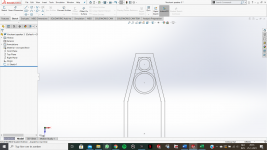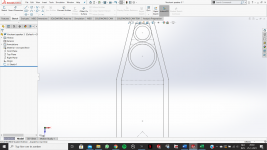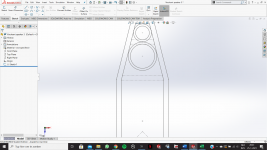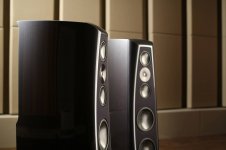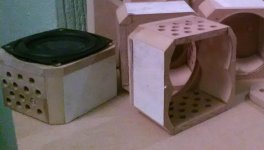Yes, for some recordings that is true, but for most it just isn't. Believe me, I used to think the same way untill I started recording myself. People should stop thinking this way otherwise it won't bring you any further. When someone is trying to sell you anything that "sound so good, it makes bad recordings even sound worse" just run away from it. Don't walk, run as fast as you can. It is nothing more than an indication of a flawed system, nomatter how good it sounds on your carefully preselected reference albums.
i agree with most of what you say, my only objection where that a perfect loudspeaker would make even the badest recording sound better - and i do not find that to be true. if one is doing a recording with flaws in the monitoring system, that flaws will creep in the recording and then be easily heard over a monitor system without these flaws
Now this has moved into the ideas I have been perusing in my months of discomfort with my current speakers, confirmed by the top 20 from 1991 on R2 just now.
If we apply the statistical Gaussian curve individually to both the quality of the recording, and the quality of the playback system, we can compare the results at each end of each of the two quality curves.
With a poor replay system, (at the low end of the replay curve), every recording will sound poor because of the inherent limiting factor of the replay system; recording quality variation will be masked/obscured by that.
If we use an extremely good replay system it will allow perception of the recording qualities across the curve through the average (peak), and then into the exceptionally good. This will be forensic in nature, a 'warts and all' revealing of what is on the recording, and perhaps only a few recordings will sound good.
It may be very uncomfortable, as much disillusioning truth is.
If we apply the statistical Gaussian curve individually to both the quality of the recording, and the quality of the playback system, we can compare the results at each end of each of the two quality curves.
With a poor replay system, (at the low end of the replay curve), every recording will sound poor because of the inherent limiting factor of the replay system; recording quality variation will be masked/obscured by that.
If we use an extremely good replay system it will allow perception of the recording qualities across the curve through the average (peak), and then into the exceptionally good. This will be forensic in nature, a 'warts and all' revealing of what is on the recording, and perhaps only a few recordings will sound good.
It may be very uncomfortable, as much disillusioning truth is.
I suffer the same issue in the ~ 2KHz - 5KHz region. I have designed an on axis dip (steep LR slopes) and thats the best compromise "so far". When I get less lazy, I'll break out the measurement setup and work out what is going on.
I thought for a long time it was my metal cone midwoofer used as a midrange. But certain tracks - it's definitely the tweeter that is dominating and sounding very forward / bright. Some driver disconnected tests and sweeps as mentioned above are a good suggestion. I will do the same.
For now I am using a Raspberry Pi server with "stored" PEQs that auto-load on certain albums. works well - hence why I haven't pushed further.
I thought for a long time it was my metal cone midwoofer used as a midrange. But certain tracks - it's definitely the tweeter that is dominating and sounding very forward / bright. Some driver disconnected tests and sweeps as mentioned above are a good suggestion. I will do the same.
For now I am using a Raspberry Pi server with "stored" PEQs that auto-load on certain albums. works well - hence why I haven't pushed further.
Design update.
I was watching an interview with Lawrence Dickie about the Vivid Audio Giya G1 Spirit. Very inspiring. And I got inspired to place the midrange and tweeter closer together. I already knew placing the tweeter and mid as close as possible is beneficial. But hearing him saying it made me do it.
So as I was redesigning the top of the loudspeaker and wanted to put the top midrange and tweeter as close together as possible. So that the cutout holes are right against the baffle that seperates the midrange and tweeter chamber.
But I also have felt on the front baffle, which is sunk in. But the midrange frame and the tweeter faceplate were only 1 mm apart and I wouldn't be able to cut the felt that shallow. The same was the case between the midrange frame and the edge of the deepening for the felt. So what I decided to do is sink in the drivers flush with the surface on which the felt will be stuck. So that the felt will go over the tweeter faceplate and the midrange frame. Then the distance between the midrange surround and tweeter and the edge of the deepening is wide enough so I would be able to cut it. It actually also has some advantages. Because the tweeter faceplate and the midrange frame will be covered in felt there will be even less reflective surface on the baffle.
And covering the midrange frame with felt has a second advantage. The vibrations of the motor travel through the basket to the outer frame of the midrange. And much faster than through the other materials. This causes the frame to radiate sound, as a second source. This polutes the midrange and getting rid of it by covering the frame has a notible effect on the purity of the midrange. Edwin Van Rijnveld, founder and designer of Siltech told me this when I spend a day with him. He also discussed this with Alon Wolf from Magico. This is the reason that now Magico and others like Boressen, Grimm and others cover up the midrange frames.
Covering it with felt won't be as effective as actually mounting the midrange behind the baffle, but it's something. And also, it actually looks super neat. Just like Rockport speakers.
Also, I actually wanted to lower speakers slightly because I actually find the tweeter to sit slightly too high when I'm sitting back comfortably. But I didn't know how to because I didn't want to lower the enclosure and take away volume from the bass chamber. I simply solved it by moving the seperating wall between the midrange and woofer chamber up. This takes away volume in the midrange chamber but this way I can keep the bass chamber volume the same and make the speaker lower. The volume of the midrange chamber is less critical. And it's still huge anyway.
Sorry for the long story. To sum it up:
-I got the midrange and tweeter as close together as they possibly could for better disperion.
-I covered the tweeter faceplate and midrange frame with felt getting rid of more reflective area and reducing the second sound emiting from the midrange frame.
-I got the tweeter on a better listening height without reducing bass chamber volume.
Very happy that I solved these problems this way.
I was watching an interview with Lawrence Dickie about the Vivid Audio Giya G1 Spirit. Very inspiring. And I got inspired to place the midrange and tweeter closer together. I already knew placing the tweeter and mid as close as possible is beneficial. But hearing him saying it made me do it.
So as I was redesigning the top of the loudspeaker and wanted to put the top midrange and tweeter as close together as possible. So that the cutout holes are right against the baffle that seperates the midrange and tweeter chamber.
But I also have felt on the front baffle, which is sunk in. But the midrange frame and the tweeter faceplate were only 1 mm apart and I wouldn't be able to cut the felt that shallow. The same was the case between the midrange frame and the edge of the deepening for the felt. So what I decided to do is sink in the drivers flush with the surface on which the felt will be stuck. So that the felt will go over the tweeter faceplate and the midrange frame. Then the distance between the midrange surround and tweeter and the edge of the deepening is wide enough so I would be able to cut it. It actually also has some advantages. Because the tweeter faceplate and the midrange frame will be covered in felt there will be even less reflective surface on the baffle.
And covering the midrange frame with felt has a second advantage. The vibrations of the motor travel through the basket to the outer frame of the midrange. And much faster than through the other materials. This causes the frame to radiate sound, as a second source. This polutes the midrange and getting rid of it by covering the frame has a notible effect on the purity of the midrange. Edwin Van Rijnveld, founder and designer of Siltech told me this when I spend a day with him. He also discussed this with Alon Wolf from Magico. This is the reason that now Magico and others like Boressen, Grimm and others cover up the midrange frames.
Covering it with felt won't be as effective as actually mounting the midrange behind the baffle, but it's something. And also, it actually looks super neat. Just like Rockport speakers.
Also, I actually wanted to lower speakers slightly because I actually find the tweeter to sit slightly too high when I'm sitting back comfortably. But I didn't know how to because I didn't want to lower the enclosure and take away volume from the bass chamber. I simply solved it by moving the seperating wall between the midrange and woofer chamber up. This takes away volume in the midrange chamber but this way I can keep the bass chamber volume the same and make the speaker lower. The volume of the midrange chamber is less critical. And it's still huge anyway.
Sorry for the long story. To sum it up:
-I got the midrange and tweeter as close together as they possibly could for better disperion.
-I covered the tweeter faceplate and midrange frame with felt getting rid of more reflective area and reducing the second sound emiting from the midrange frame.
-I got the tweeter on a better listening height without reducing bass chamber volume.
Very happy that I solved these problems this way.
Attachments
driver baskets should not be a source of noise of very high levels, i believe you can use a screwdriver as stethoscope to find out
driver center-to-center distance is most of a concern if you sit close to the speakers, even some top ranked speakers has a rather large c-t-c, i guess this is a question of how the speakers are meant to be used
driver center-to-center distance is most of a concern if you sit close to the speakers, even some top ranked speakers has a rather large c-t-c, i guess this is a question of how the speakers are meant to be used
The sound emiting from the basket of the midrange will definately be of a very low level. But it does have an audible effect. And if Edwin Van Rijnveld and Alon Wolf agree on it. I'll definately believe it.
Well my current listening space is very small and it does have an effect when I'm sitting more upstraight or more laid back. And still the closer they are together the better the dispersion will be. And even though the effect might be minimal, I'm willing to squeeze as much performance as possible from this design (to a certain degree of course).
Well my current listening space is very small and it does have an effect when I'm sitting more upstraight or more laid back. And still the closer they are together the better the dispersion will be. And even though the effect might be minimal, I'm willing to squeeze as much performance as possible from this design (to a certain degree of course).
I think you are overlooking much more likely candidates for bright / bad upper mid / lower treble, than basket vibration.
Can you honestly hear a difference? (hard to do unless you are A/B switching instantaneously across both speakers - one setup old and one with the new felt / changes).
Assuming you do hear a difference... has it solved the problem? are we job done here?
If not - I go back to my point of something more fundamental.
In terms of C-to-C spacing.. This only affects lobing. A simple test would be to find a vertical position playing a track over and over where the forwardness "goes away". But then all you are hearing is a midrange / treble dip caused by lobing. It might give you a sweet spot listening position though. If you can't hear a difference, either the C-t-C spacing is not a factor, or the room or inherent driver behaviour is swamping the response.
I often wondered with mine whether I simply move outside to remove the room from the equation. I'd have to be mindful to adjust to a lack of bass from room re-inforcement, but my solution here is to dial down the bass (or remove the woofer entirely from the chain) indoors, then move outdoors. See if the brightness/ forwardness goes away.
Can you honestly hear a difference? (hard to do unless you are A/B switching instantaneously across both speakers - one setup old and one with the new felt / changes).
Assuming you do hear a difference... has it solved the problem? are we job done here?
If not - I go back to my point of something more fundamental.
In terms of C-to-C spacing.. This only affects lobing. A simple test would be to find a vertical position playing a track over and over where the forwardness "goes away". But then all you are hearing is a midrange / treble dip caused by lobing. It might give you a sweet spot listening position though. If you can't hear a difference, either the C-t-C spacing is not a factor, or the room or inherent driver behaviour is swamping the response.
I often wondered with mine whether I simply move outside to remove the room from the equation. I'd have to be mindful to adjust to a lack of bass from room re-inforcement, but my solution here is to dial down the bass (or remove the woofer entirely from the chain) indoors, then move outdoors. See if the brightness/ forwardness goes away.
Of course this won't solve the problem I currently have with the frequency response. These are just the things I'm going to add when I'm building the new pair. Om not building the new pair to solve the current problem.
I don't think we're suggesting a good speaker can make a bad recording sound better, at least I'm not.. it's the other way around.my only objection where that a perfect loudspeaker would make even the badest recording sound better - and i do not find that to be true.
Of course this won't solve the problem I currently have with the frequency response. These are just the things I'm going to add when I'm building the new pair. Om not building the new pair to solve the current problem.
Always good to have things to add to improve the next design... But equally important is understanding what failed in the current design (to avoid repeating it).
Well the only thing that might be called a real "mistake" was the round top. But that's why I changed it to th square top.
Further they are just small improvements that I didn't think of before.
Another thing I thought of yesterday. Right now the sides of the braces in the midrange chamber are flat. So they reflect sound from the midrange driver right back. On the new pair I will make those sides pointy like the edge of a knife. So it doesn't reflect the sound right back.
They are all small improvements but I'm very curious what they'll bring performance wise when the new pair is done. Obviously it won't be a night and day difference. I'm expecting it to make the midrange a little bit purer. And maybe slightly improved imaging because the midrange and tweeter are so close together.
Obviously the difference will be very small. But perfection is in the details.
Further they are just small improvements that I didn't think of before.
Another thing I thought of yesterday. Right now the sides of the braces in the midrange chamber are flat. So they reflect sound from the midrange driver right back. On the new pair I will make those sides pointy like the edge of a knife. So it doesn't reflect the sound right back.
They are all small improvements but I'm very curious what they'll bring performance wise when the new pair is done. Obviously it won't be a night and day difference. I'm expecting it to make the midrange a little bit purer. And maybe slightly improved imaging because the midrange and tweeter are so close together.
Obviously the difference will be very small. But perfection is in the details.
When a neutral system accurately reveals all recordings, I find that the recordings considered to be bad, are a pleasure to hear. Some could have bass relative to treble adjusted.
Thanks for clarifying, J. W. !
So, bad recordings are non-existent, only bad speakers. To your mind.
That's a little hope for anyone (including me) who thinks bad recordings do exist.
So, bad recordings are non-existent, only bad speakers. To your mind.
That's a little hope for anyone (including me) who thinks bad recordings do exist.
🙂 At least one thing is quite probable or even sure: speakers do not make recordings good or bad. Recordings are what they are.
Speakers convert electrical signal to sound waves, succeeding in it better or worse along with room acoustics, electronics and other setup. Designer has excellent possibilities to make decisions how sound waves are created and reflected/diffused in order to get high quality reproduction so that it's tempting to listen wide variety of recordings. Not the other way around.
Speakers convert electrical signal to sound waves, succeeding in it better or worse along with room acoustics, electronics and other setup. Designer has excellent possibilities to make decisions how sound waves are created and reflected/diffused in order to get high quality reproduction so that it's tempting to listen wide variety of recordings. Not the other way around.
"So, bad recordings are non-existent, only bad speakers. To your mind."
No bad ones, but but some re-mastered recordings improve over the original... When the speaker is coloring any recording, I find it objectionable and work at finding the issue with the goal of removing it. so yes, only bad speakers!
Extremely well explained by Kimmosto, Thank You! Still, some(not me) feel recordings are deficient in some way, that an added system color or effect is needed. ie x 2, resonant bass or warming effect of a particular tube distortion.
Toole mentions that understanding and appreciating Hi Fidelity is a "learned thing" True but doesn't seem to work for everyone when I try to explain to a friend the Television vs audio System parallel, a clear noise free picture and sound of the source material. Friend doesn't see the comparison - All TV/video is about resolution and clarity, speaker sounds are all over the place and each person needs to pick one!
No bad ones, but but some re-mastered recordings improve over the original... When the speaker is coloring any recording, I find it objectionable and work at finding the issue with the goal of removing it. so yes, only bad speakers!
Extremely well explained by Kimmosto, Thank You! Still, some(not me) feel recordings are deficient in some way, that an added system color or effect is needed. ie x 2, resonant bass or warming effect of a particular tube distortion.
Toole mentions that understanding and appreciating Hi Fidelity is a "learned thing" True but doesn't seem to work for everyone when I try to explain to a friend the Television vs audio System parallel, a clear noise free picture and sound of the source material. Friend doesn't see the comparison - All TV/video is about resolution and clarity, speaker sounds are all over the place and each person needs to pick one!
Last edited:
Well the only thing that might be called a real "mistake" was the round top. But that's why I changed it to th square top.
Neither a round top nor a flat top is inherently better than the other. Baffle diffraction is affected by 3 things - cabinet dimensions, driver position and edge/surface treatment. You can just as easily get a decent diffraction response from either a flat top or a round top if the driver is in the right location depending on the cabinet dimensions. Furthermore, although this is kind of mute when you are using a driver that begins with an extremely flat response, it's not just the diffraction response that is important, it's how the diffraction response and the driver response combine together that matter the most.
Just randomly changing your baffle shape is sloppy work. Instead, use a diffraction simulation program to find out what the best combination of size and positioning are for the drivers in question. Better still to make some real world prototypes afterward with something like cardboard or bristol board or rigid foam insulation sheets if necessary, and then measure the results before you build the final cabinets.
Right now the sides of the braces in the midrange chamber are flat. So they reflect sound from the midrange driver right back. On the new pair I will make those sides pointy like the edge of a knife. So it doesn't reflect the sound right back.
I used to think this way when I started out too. Then I did some research. The question of whether or not a sound wave will be reflected by an obstacle or whether it will simply wrap around the obstacle is dependent on the size of the wavelength vs the size of the obstacle. If the wavelength is approximately equal to or smaller than the width of the object, it will be reflected. But if the wavelength is greater than the width of the object it will effectively ignore it and just wrap around the obstacle. The frequency of a wave with a length of 3/4" (the assumed width of your bracing) is about 18,000Hz. So unless your mid is popping out some extremely high frequencies, keeping the brace edges flat or rounding them over will make absolutely no difference. But have at it if it makes you feel better and that makes you think the speakers sound better but it's not based on the science.
I skipped through the last page and have not seen measurements. 3wayaddict, did you make new frequency response measurements with the right gate settings? It could point out why you experience a lack of warmth.
Last edited:
I haven't read the entire thread. Do you use felt damping inside? How about felt around the mid and tweeter? In my better designs; I use felt inside and out. I also use foam pyramids inside behind the driver baskets and then poly' fill for the rest of the cavity; 35% to 75% depending on many things. I also sometimes use thick, high density cork on the baffle between the driver frame and baffle board. I have class D amps for the lower woofer and sub woofer, everything else uses class A/B. Do you think maybe class D in the mids or highs could be too "edgy" ??? My latest LP on the MR16 mid is a single 14 AWG flat foil. Electrically, the F0 is lower than would normally be with a higher order passive X/O but the rising FR of the MR16 gets a more gentle (combined acoustic/electric) roll off than true 1st order. Can you adjust the order with the active X/O. Q???
Instead, use a diffraction simulation program to find out what the best combination of size and positioning are for the drivers in question. Better still to make some real world prototypes...
Basic diffraction simulation is valuable for baffle loss and directivity estimation at low...mid but not much for tweeter. Diffraction affects to directivity so there no good single position if enclosure is classic box with sharp edges. On axis could be okay but many other directions are just random, and power and ERs probably fail if crossover is optimized by on axis. Solution for conventional tweeters is kinda convex wave guide; rounding or rounded bevels with adequate radius.
- Home
- Loudspeakers
- Multi-Way
- In need of warmth
